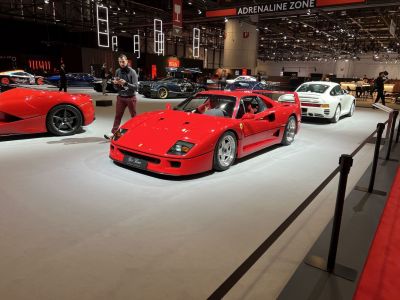 1990 Vector W8 Twin Turbo Dimensions, Size & Specs
1990 Vector W8 Twin Turbo Dimensions, Size & SpecsMeasurements of the 1990 Vector W8 Twin Turbo, engineered for optimal performance and comfort
| Dimensions | |
|---|---|
| Length: | 4370 mm172.0 in14.3 ft |
| Width: | 1930 mm76.0 in6.3 ft |
| Height: | 1080 mm42.5 in3.5 ft |
| Trunk Capacity: | 115 liter4.1 cu ft |
| Trunk Capacity (Max): | 200 liter7.1 cu ft |
| Weight Specifications | |
| Curb Weight: | 1620 kg3571 lbs |
The Vector W8 Twin Turbo, produced between 1989 and 1993, is a remarkable American sports coupe notable for its aggressive styling and powerful performance. Launched as a 1990 model, this vehicle stands out not only for its twin-turbocharged engine but also for its distinct size and proportions. Measuring 4370 mm (172 inches) in length, 1930 mm (76 inches) in width, and a low height of just 1080 mm (42.5 inches), the Vector W8 offers a sleek, aerodynamic profile characteristic of top-tier supercars of its era. Despite its relatively compact footprint compared to modern grand tourers, the car maintains a substantial presence on the road due to its wide stance and low-slung body. The Vector W8's curb weight is approximately 1620 kg (3570 lbs), which balances structural rigidity with the performance demands of its powerful twin-turbo V8 engine. Storage space is modest, reflecting its focus on high performance rather than utility, with a luggage capacity of 115 liters (4.1 cubic feet) expanding to 200 liters (7 cubic feet) when rear seats are folded down. This limited capacity qualifies the W8 as a primarily driver-focused coupe. Overall, the Vector W8 Twin Turbo remains a fascinating example of late-20th-century supercar engineering, blending American muscle with exotic design and dimensions that appeal to collectors and enthusiasts interested in distinctive sports coupes with compact yet purposeful size.
Discover the standout features that make the 1990 Vector W8 Twin Turbo a leader in its class
Have a question? Please check our knowledgebase first.
The Vector W8 Twin Turbo from the 1990 model year measures 4370 mm (171.9 inches) in length, 1930 mm (75.9 inches) in width, and 1080 mm (42.5 inches) in height. These dimensions place it firmly in the category of a low-slung, wide sports coupe optimized for aerodynamic performance and road presence. Its compact height underlines its supercar styling with an aggressive stance.
The Vector W8 Twin Turbo weighs approximately 1620 kg (3571 lbs) at curb weight. This relatively moderate weight for a supercar of its era, combined with its powerful twin-turbocharged V8 engine, allows the car to deliver exceptional acceleration and handling dynamics. The weight was carefully balanced to optimize traction and stability while maximizing speed and agility on the road.
The Vector W8 Twin Turbo offers 115 liters (4.1 cubic feet) of luggage space in its standard configuration. When the rear seats are folded down, the available luggage capacity expands to 200 liters (7.1 cubic feet). This is relatively small compared to conventional vehicles but typical for an exotic sports coupe prioritizing performance and design over cargo space.
Yes, the Vector W8 Twin Turbo does fit into a standard residential garage in most cases. Its length of 4370 mm (171.9 inches) and width of 1930 mm (75.9 inches) fall within typical garage dimensions, which usually accommodate cars up to about 6 meters (20 feet) in length and 2.4 meters (7.9 feet) in width. However, due to its low height of 1080 mm (42.5 inches), special care should be taken when parking to avoid any damage, but overall the W8's dimensions are garage-friendly.
At 1930 mm (75.9 inches) wide, the Vector W8 Twin Turbo is wider than many other sports cars of the early 1990s, such as the Ferrari F355 which is about 1908 mm (75.1 inches) wide and the Lamborghini Diablo at about 2030 mm (79.9 inches) wide. This width helps the W8 achieve enhanced road grip and stability at high speeds, contributing to its reputation as a well-handling supercar.
Measuring just 1080 mm (42.5 inches) in height, the Vector W8 Twin Turbo is remarkably low, which greatly aids its aerodynamic profile. This low height reduces air resistance and improves high-speed stability, essential for a supercar designed to achieve high velocities exceeding 300 km/h (186 mph). The sleek profile also enhances visual appeal, emphasizing its exotic and aggressive design.
The Vector W8 Twin Turbo maintains a similar compact footprint to earlier Vector models but exhibits refined dimensions with a slight increase in width and aerodynamic efficiency. Earlier Vector models were slightly shorter and narrower, but the W8’s 4370 mm (171.9 inches) length and 1930 mm (75.9 inches) width represent a shift towards a wider stance to improve handling and stability. These dimensional changes complement the upgraded performance and styling of the W8 generation.
The Vector W8 Twin Turbo’s dimensions are competitive among early '90s supercars. For comparison, the Lamborghini Diablo is longer at approximately 4485 mm (176.6 inches) and wider at 2030 mm (79.9 inches), while the Ferrari F355 is slightly shorter and narrower at 4355 mm (171.5 inches) length and 1908 mm (75.1 inches) width. The Vector’s low height of 1080 mm (42.5 inches) is lower than most competitors, emphasizing a unique aerodynamic and aggressive profile.
The Vector W8 Twin Turbo is a two-seater coupe with an interior designed to maximize driver engagement and luxury within a compact space. While exact interior cabin dimensions are less widely published, the car’s overall width of 1930 mm (75.9 inches) provides a snug cockpit typical of exotic sports cars. Its low roofline (1080 mm / 42.5 inches height) means headroom is limited, favoring aerodynamic design over spaciousness. The luggage space is modest, reinforcing the car’s sports-focused nature.
The Vector W8 Twin Turbo offers limited luggage capacity – 115 liters (4.1 cubic feet) normally and 200 liters (7.1 cubic feet) with folding rear seats – which restricts its practicality for daily errands or long trips requiring substantial cargo. This is typical for rare high-performance supercars that prioritize speed and styling over utility. Owners should anticipate limited storage for luggage or groceries, making it more suitable for enthusiasts who value driving experience over everyday utility.
Discover similar sized cars.

| Production: | 1987-1992 |
|---|---|
| Model Year: | 1987 |
| Length: | 4358 mm171.6 in |
| Width: | 1970 mm77.6 in |
| Height: | 1124 mm44.3 in |
